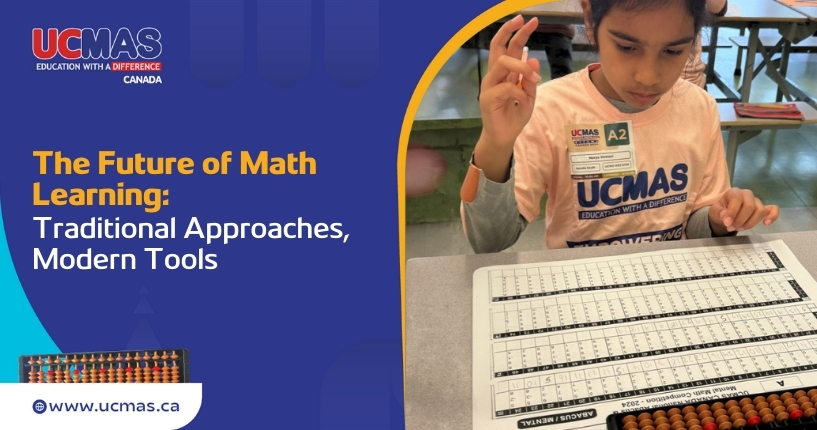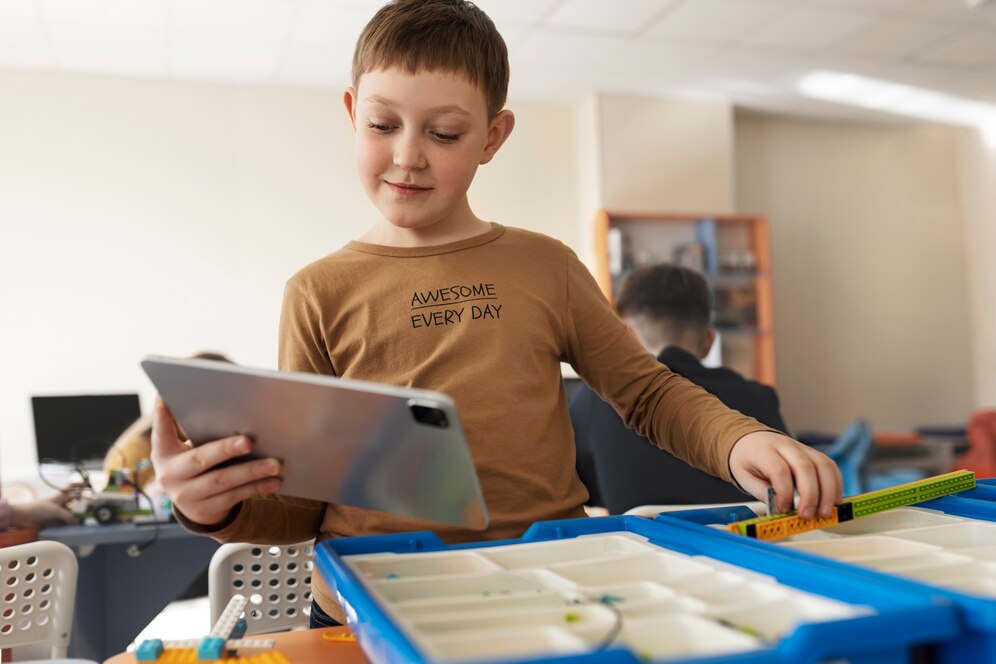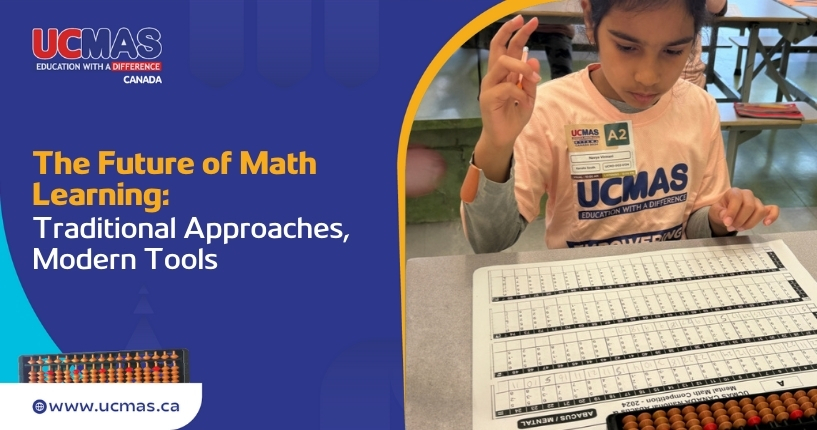
Can Technology Help Students Learn Math? Let’s Uncover the Truth
In today’s digital age, the integration of technology into education has become increasingly prevalent. As parents and educators, we often wonder: can technology truly enhance our children’s math learning experience?
A study involving 10 case studies across various schools found that students using technology in math classrooms experienced higher engagement. (Source: Science Direct)
Teachers observed an increase in student confidence and academic achievement, particularly in challenging and relevant tasks while teacher awareness increased by 36% in cases where technology allowed teachers to understand and respond to individual student learning needs.
At UCMAS, we believe in leveraging the best of both worlds – abacus techniques and cutting-edge technology – to provide a comprehensive math education. Let’s explore how technology can be a powerful ally in helping students master skills.
The Power of Digital, Engaging Worksheets

Gone are the days of mundane, repetitive math drills on paper. Digital mental math worksheets have revolutionized the way students practice mathematical concepts. These interactive tools offer several advantages:
1. Immediate Feedback for Faster Learning
One of the most significant advantages of digital worksheets is their ability to provide instant feedback. Unlike traditional mental math worksheets, where students might have to wait until the next day to see corrections, digital platforms highlight mistakes immediately. This real-time response helps students quickly identify areas where they went wrong and allows them to correct their techniques on the spot. As a result, learning is more dynamic and efficient—students can immediately apply the correct methods and move forward with confidence.
2. Adaptive Learning for Personalized Progress
Every student learns at their own pace, and digital mental math worksheets can cater to these individual needs. Thanks to adaptive learning technology, the difficulty of exercises can automatically adjust based on a student’s performance. If a student is breezing through easier problems, the worksheet may present them with more challenging tasks, pushing them to expand their skills. On the other hand, if a student struggles with a particular concept, the platform can provide additional practice at that level to help them master it. This personalized learning experience ensures that students are neither bored with too-simple exercises nor overwhelmed by tasks that are too difficult.
3. Gamification for Maximum Engagement
Solving math problems doesn’t have to feel like a chore. Digital worksheets often incorporate gamification elements to keep students motivated and engaged. Features like progress bars, achievement badges, and point-based rewards create a sense of accomplishment. These elements tap into the natural human desire for progress and achievement, transforming math practice into a more enjoyable and rewarding experience. The thrill of earning a badge or unlocking a new level adds an element of excitement that encourages students to keep practicing without feeling like they are simply “doing more math.”
Additionally, UCMAS offers a dedicated mobile app that transforms learning into an engaging experience. Students can score points based on speed and accuracy, all within a game-like environment, making practice both fun and effective. Check out the app here.
4. Visual and Interactive Tools for Deeper Understanding
Digital mental math worksheets are an excellent resource for students to practice and improve their arithmetic skills. These worksheets provide a structured format to help students master essential math concepts through repetitive practice. At UCMAS, the books feature QR codes on each worksheet page. If a child struggles with a problem, they can simply scan the QR code to access helpful tutorials, ensuring they get the support they need right when they need it.
Moreover, UCMAS Course Instructors have their own mobile app to stay updated with the curriculum and advanced methods like the 6-finger techniques, ensuring teachers are always equipped with the latest teaching strategies.
In conclusion, digital mental math worksheets offer a more engaging, flexible, and effective approach to learning math. Students can work at their own pace, receive personalized challenges, and stay motivated through gamified rewards—all while developing a stronger understanding of mathematical concepts. This combination of learning and fun transforms the way students approach math practice, making it an activity they look forward to rather than one they dread.
UCMAS Online Classes: A New Frontier in Math Education
The COVID-19 pandemic catalyzed the adoption of online learning, and at UCMAS, we’ve embraced this change wholeheartedly. In areas and cities where UCMAS centres are far or unavailable, we provide the alternative of attending abacus online classes, thereby blending the traditional abacus techniques and modern technology:
- Interactive learning environment: Students can participate in real-time problem-solving sessions, fostering active engagement.
- Personalized attention: Course instructors can provide individualized feedback and support, even in a virtual setting.
- Rich learning material: From virtual abacus simulators to animated concept explanations, our online classes leverage multimedia to enhance understanding.
Children who frequently used an educational math app over two weeks showed a 15% improvement in math skills compared to those who did not, according to a study conducted by the Joan Ganz Cooney Centre at Sesame Workshop.
Research conducted at Sesame Workshop by the Joan Ganz Cooney Centre emphasizes the significance of technology in education, particularly when it comes to educational apps. These figures demonstrate how well digital learning resources can support conventional teaching techniques. Children can have a more enjoyable, engaging, and personalized approach to mathematics by including well-designed educational applications in their learning experiences, which will result in quantifiable increases in their skills.
Striking the Right Balance
While technology offers numerous benefits, it’s crucial to maintain a balance in math education. Here’s why:
- Social interaction: In-person classes provide valuable opportunities for students to interact with each other.
- Tactile learning: Physical manipulation of objects, like an abacus, develops spatial reasoning and motor skills.
- Screen time concerns: Excessive screen time can lead to eye strain and reduced physical activity.
The UCMAS Approach: Combining Tradition and Technology
Our Mental Math Worksheets exemplify this balanced approach. While rooted in traditional abacus techniques, these worksheets are available both in print and digital formats, catering to different learning preferences.
Technology, when used thoughtfully, can indeed be a powerful tool in helping students learn math. From engaging digital worksheets to interactive online classes and educational games, these tools offer new ways to practice, understand, and apply mathematical concepts. However, it’s essential to strike a balance, combining the best of traditional methods with innovative technology.
At UCMAS, we’re committed to providing a comprehensive math education that prepares students for the digital age while preserving the timeless benefits of abacus learning. Whether through our Abacus Classes Online or our carefully crafted Mental Math Worksheets, we’re here to support your child’s mathematical journey.
Ready to explore the perfect blend of tradition and technology in math education?
Enrol now and discover how we can help your child excel in mathematics, one calculation at a time!






